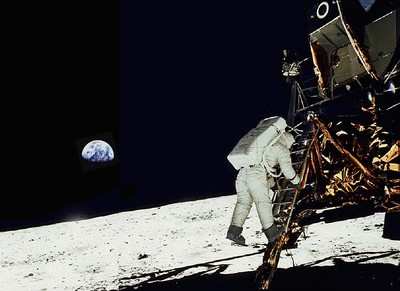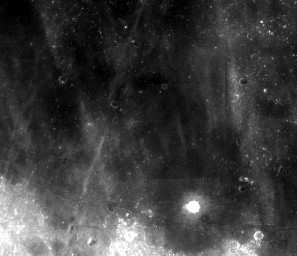And That Could Be Reason Enough To Return
The current value of pure gold (Au), at today's price is $15,500
per kilogram.
So consider: Helium-3 (He3) a rare particle on Earth but
abundant on the Moons lunar surface (He3 is required for a fusion
reactant - safe nuclear energy) has an energy value in today's
dollars is $5.7 million per kilogram when compared to the value and
energy potential of oil.

On January 14, 2004 US President Bush announced a new vision for
NASA that incorporated a human return to the Moon by 2020,
follow-on exploration of Mars and other destinations.
A recent meeting of some 200 scientists from 17 countries
expects "lunar landers cooperating into an international lunar
robotic village before 2014", evolving technologies for
human-tended missions that prepare the ground for an "effective,
affordable human lunar exploration and permanent presence by
2024."
Nuclear fusion holds the promise of producing massive amounts of
energy without the radioactive byproducts of fission-powered
plants.
Dr. Larry Taylor director of UT's Planetary Geosciences
Institute in Knoxville says, "The moon is an orbiting space
station. All the things you might need for planetary travel are
there—hydrogen, oxygen, carbon, and other essentials. You can
find ways to process or mine the moon and its soil, but there's a
lot of stuff up there we could use down here too. The abundance of
helium on the moon represents "the Persian Gulf of energy in the
21st century." Helium, with an atomic mass of 3, could have huge
importance for generating energy on earth. In 1999 Taylor wrote,
"There is more than 100 times more energy in the helium-3 on the
moon than in all the economically recoverable coal, oil, and
natural gas on earth."
Scientists estimate there are about 1 million tons of helium 3
on the moon, enough to power the world for thousands of years. The
He3 is mainly imbedded in an ore called ilmenite.
A space vehicle with a payload bay the size of a space shuttle
could bring back enough helium-3 to generate the electricity to
satisfy the United States' needs for a full year.
Particles of hydrogen and helium in the solar wind that strikes
the moon become embedded in the rocks and soil. This doesn't happen
on the earth because our atmosphere and our magnetic field shield
our planet from these solar particles.
It has been estimated that helium 3 would have a cash value of
$5.7 billion a ton in terms of its current energy equivalent to oil
at <$40 per barrel oil.
At $40,000 to $60,000 per kilo for transporting materials from
Earth to the Moon, it is not cost effective to go to the Moon even
for pure gold (Au), at today's price of <$15,500 per kilogram.
He3 equivalent energy value in today's dollars is $5.7 Million per
kilogram making this venture for the He3 fusion reactant worth the
effort and cost.
While the vehicles for retrieving resources from the moon are
being designed and built, Taylor thinks the nation—and the
world—can speed research and development of fusion reactors
that could process helium trapped in lunar material.
However, a loophole in Space Law allows individuals and
companies to hold Mineral Rights on the Moon, Mars and other
celestial bodies. Growing concern from Scientists that these rights
may be held hostage have been alleviated by a three man North
American team; Dr. Joseph Resnick, Dr. Timothy R. O'Neill and Guy
Cramer (ROC-Resnick/O'Neill/Cramer team) who have acquired the
mineral rights for 95% of the side of the moon that faces Earth,
the polar regions and 50% of the far side of the moon.

After setting aside 8.9 million acres around Apollo 11 Lunar
landing site and designated as a "World Heritage Site". The ROC
team announced that it was holding more than 75% of the Lunar
Mineral rights to allow for the extraction of Helium-3 and other
minerals for the advancement of Space Exploration, Earth and Space
Sciences and safer more efficient energy production.
With the mineral rights secured, the ROC team wants to oversee
the extraction process for He3 and other minerals for any robotic
or human ventures to obtain these materials to ensure the Moon
doesn't become a series of scared surface mines visible from Earth
or future lunar orbiting space stations. Visual Mitigation will be
a priority so that the expected large scale strip mining doesn't
turn the moon into an eyesore for the rest of us.
While the ROC team could become the DeBeers of He3 they have
decided that the isotope should not be run like a commodity to
profit from - given the important nature of He3 and costs in
travel, mining, acquiring, refining and transporting it back to
Earth. However, future mineral extraction will require a small
lease to cover the costs of planning for visual mitigation and
environmental oversight by the ROC team. "The Lunar surface will
have to look the same after the mining is done as it was prior to
the mining. The environmental and visual preservation must be
factored into any planning of future lunar mines."

While efficient He3 reactors are still being tested and refined,
many advances have been made in the past few years. Only a few
pounds of helium 3 are known to exist on Earth, most the by-product
of nuclear-weapon production.
Reactors that exploit the fusion of deuterium and tritium
release 80 percent of their energy in the form of radioactive
neutrons, which exponentially increase production and safety costs,
states Gerald Kulcinski, Director of the Fusion Technology
Institute (FTI) at the University of Wisconsin at Madison.
In contrast, helium 3 fusion would produce little residual
radioactivity. Helium 3, an isotope of the familiar helium used to
inflate balloons and blimps, has a nucleus with two protons and one
neutron. A nuclear reactor based on the fusion of helium 3 and
deuterium, which has a single nuclear proton and neutron, would
produce very few neutrons -- about 1 percent of the number
generated by the deuterium-tritium reaction. "You could safely
build a helium 3 plant in the middle of a big city," Kulcinski
said.
Helium 3 fusion is also ideal for powering spacecraft and
interstellar travel. While offering the high performance power of
fusion -- "a classic Buck Rogers propulsion system" -- helium 3
rockets would require less radioactive shielding, lightening the
load, said Robert Frisbee, an advanced propulsion engineer at
NASA's Jet Propulsion Laboratory in Pasadena California.
Wisconsin researchers have produced protons from a steady-state
deuterium-helium 3 plasma at a rate of 2.6 million reactions per
second in a chamber, which is roughly the size of a basketball.
"It's proof of principle, but a long way from producing electricity
or making a power source out of it," Kulcinski said. The next
generation of helium 3 fusion reactors are expected to be
completely void of radiation.
While it's true that to produce roughly 70 tons of helium 3, for
example, a million tons of lunar soil would need to be heated to
1,470 degrees Fahrenheit (800 degrees Celsius) to liberate the gas.
"There's enough in the Mare Tranquillitatis alone to last for
several hundred years," according to Apollo17 astronaut and FTI
researcher Harrison Schmitt. "Besides the helium, a mining process
would produce water and oxygen as by-products," he says.

70 Tons of helium-3 would have a cash value of $400 Billion in
terms of its current energy equivalent in oil.
Following an idea put forward by two European scientists of
conserving distinct regions on Mars, the ROC team acquired the
mineral rights to Seven hundred million acres of Mars and
designated these 8 regions as the first "Extraterrestrial Nature
Preserves". The team has agreed to set them aside as preserve
regions, prior to the public and corporate ability to obtain those
rights.
Resnick, a former NASA scientist and current consultant to NASA,
said, "Space law does not allow countries to have land ownership on
planets and moons in the solar system but it does allow for the
Mineral Rights to be obtained by individuals and companies. The
countries party to the Space Treat Act have agreed that none of
them has either jurisdiction nor ownership of any extraterrestrial
body, nor samples."
Resnick says he found the loophole in Space Law 25 years ago
that allowed him ownership of all planetary bodies outside the
"Third Planet from the Sun"... submitted this to the World Court at
the Hague, and to the United Nations in New York City. In 25+ years
no one has ever disputed Resnick's claimed ownership.
Resnick was structuring the Universal Mineral Leases Registry
(UMLR) when his partner, Guy Cramer, had read the article on the
Mars parks proposal and discussed the ability with Resnick and
O'Neill to implement the preserve idea into reality through the
UMLR. The ROC team agreed and decided to obtain the mineral rights
to these regions, to set them aside as protected areas, prior to
the public launch of the UMLR.
This loophole in Space law has been a growing concern to
Scientists, however, most were unaware that Resnick had foreseen
some of these issues long ago when he obtained ownership of the
mineral rights.

Each of the Mars designated areas contain representative
features on Mars including the solar systems largest Volcano, Mon
Olympus, three times the altitude of Mount Everest and is as wide
as the entire chain of Hawaiian Islands as well as the deepest
Trench in the Solar System, Valles Marineris which is a giant
canyon system that runs about 3000 miles (4800 kilometers) long,
meaning on Earth it would stretch all the way from New York City to
Los Angeles! The widest point is about 600 kilometers across, and
at its deepest point Valles Marineris is about 10 kilometers from
top to bottom. This is 6 times deeper than the Grand Canyon in
Arizona. The designated historical park holds the landing sites of
the Viking 1 and Mars Pathfinder spacecraft. Five other regions
have also been allocated for preservation.
The North American team issued this statement "We support the
effort to protect these Martian areas and by virtue of 'owership'
via the Universal Mineral Leases Registry (UMLR), we are
designating the areas as "preserves". This effort constitutes the
first-of-a-kind "Extraterrestrial Nature Preserve" established by
human beings and sanctioned by the owners of the mineral rights
located in the Mars regions. Furthermore we have obtained the
mineral rights for a large Lunar area surrounding the Apollo 11
landing site and designated this area as a "World Heritage Site"
which will allow our future space fairing decedents the opportunity
to see this site as it remains on the timeless lunar soil of our
first astronauts landing on another celestial body".
This UMLR is filed with the US Patent and Trademark Office and
updated semi-annually.
The ROC Team has acquired a few other sites of interest on Mars
and the Moon through the UMLR that are of scientific interest, but
they have not designated those areas for protection from mineral
acquisition or mining. Consideration will been given by the team to
allowing countries open access to most of those areas for
selections of landing sites to optimize the science return and
benefit for exploration.
The ROC team is expected to work with NASA's Moon-Mars and
Beyond Initiative and International Space Agencies to set aside
specific regions of interest for potential; landing, launch,
habitat, exploration, environmental, communication,
experimentation, industrialization and commercialization
sites.
 ANN's Daily Aero-Linx (04.13.24)
ANN's Daily Aero-Linx (04.13.24) ANN's Daily Aero-Term (04.13.24): Beyond Visual Line Of Sight (BVLOS)
ANN's Daily Aero-Term (04.13.24): Beyond Visual Line Of Sight (BVLOS) Airborne 04.09.24: SnF24!, Piper-DeltaHawk!, Fisher Update, Junkers
Airborne 04.09.24: SnF24!, Piper-DeltaHawk!, Fisher Update, Junkers Aero-News: Quote of the Day (04.14.24)
Aero-News: Quote of the Day (04.14.24) ANN's Daily Aero-Term (04.14.24): Maximum Authorized Altitude
ANN's Daily Aero-Term (04.14.24): Maximum Authorized Altitude







